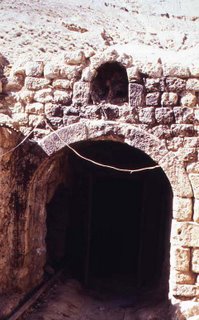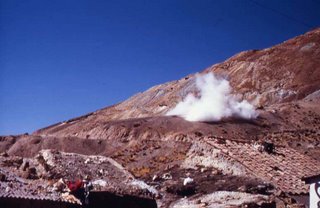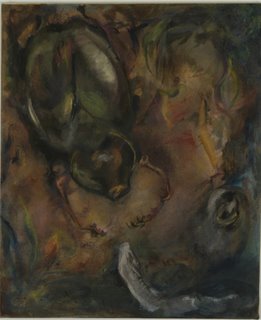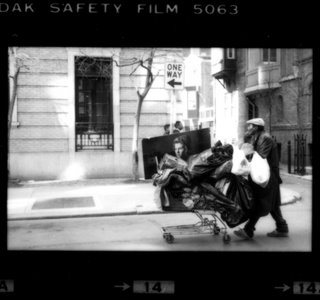05 August 2006
Bolivian mine tour

Enter only if you have an extra lung
The mine tour operator is a nice guy, you find him outside the one hotel in the windswept, infinitely sad city of Potosi. It is one of the highest cities in the world, just at the edge where human beings can live without deteriorating rapidly. The sunset brings black stiff winds, and the lights which line the street market stalls are helpless against it.
The tour operator finds the appropriate minibus; he pays for "dos gringos en uno negro." As gringos typically pay higher for everything in this country. You do not go directly to the mine, but into town to the outdoor stalls. You cannot show up at the mine empty handed. The miners require gifts. Primarily dynamite, fuses and coca leaves.
The dynamite is to blow holes in the rock to find more silver. The coca is to numb one's skull in order to work in perhaps one of the most difficult jobs in the world. Coca is what they make cocaine out of. Chewing the leaves gives a milder buzz, numbs up the mouth and provide an inoculation of euphoria against the rigors of a low-oxygen environment.
The guide knows what you should buy. You pinch some of the coca leaves and use the special activator compound that you rub on your gums to get the full extraction.

no permit required
You chew on the coca leaves because you are ascending. The town of Potosi is already high enough for anybody with only two lungs. The minibus climbs quickly into a mountainous wasteland.
The tour guide tells you the basics. Spanish come along raping and pillaging and find huge vein of silver in mine nearby. They try to import African slaves to work the mine but the conditions are too difficult and they die too quickly. So they conscript locals to work the mines, giving them a pittance while shipping most the swag back to fund disastrous religious wars.
The mine has long ago lost its power to make one rich. Now a few short-statured and short-lived locals press on against the rock, finding small pockets here and there. The dynamite is apparently a dangerous mining technique necessitated by the paucity of the good stuff left in the mountain.

Like they used to, with corresponding
high mortality rates
The tour guide operator comes from a family of miners. All the other miners know him and appear to like him. They also like the looks of the 'gifts' you have bought. They seize upon the coca leaves and stick them in already bursting cheeks. You take a little yourself as the altitude up here is ridiculous. You look into the holes, it does not look terribly appealing.
Because you do not act like typical gringos and have brought much coca, the miners take a shine to you. They offer to blow up one of the sticks of dynamite you have brought. You agree that this would be a fun activity.

Men with other men blowing things up
But enough terrestrial fun. Now it is time to go into the hole. You are given filthy hard hats and told to alert the guide if you feel ready to pass out. This is not the first time you have heard this warning in this country.

Is there lunch on this tour?
The tour guide mistakes you for fit. This is no average gringo tour. He takes you deep into the mine, where there you are still 16,000 feet above sea level and also at the bottom of a deep dank hole. You do not feel well from the start. The fumes, the lack of oxygen. How in god's name does anybody go in these holes and pound away at this rock every day?
There are some mechanical tools, but much also is done by hand. Small brown men with sad eyes pound the rock with hammers. The tour guide tells us that it is very much a family business. Sons follow fathers into the mine with a faustian bargain: a little better life than the average desperately poor Bolivian in exchange for an early death due to lung disease.
Then the tour operator casually mentions that he already has lung disease from the short time he spent in the mine as a kid.

As dad used to say, "Work a little while in a Bolivan mine and then let me hear you complain."
The Potosi mine tour has everything you might imagine. Filth, murky tunnels, frightening belly-crawls through tiny blown apertures in the rock, a recent dynamite explosion and subsequent poison gasses.
Frankly it is flabbergasting that the miners last as long as they do, working in the conditions they do. The perilous life they lead makes them naturally attracted to divine assistance such as they can get. The tour guide takes you to a rock cul-de-sac where the miners give offerings to an old mountain god. As bad as you feel and as claustrophobic as you are, you do too.

Another coca leaf another day of protection
#
04 August 2006
Bolivian mountains through a UV filter

At 20,000 feet you hear alot of wind and are glad the glasses are 100% UV

The sky blackens at the upper reaches, a little too close to outer space.

At the top of the mountain only a reminder of how many.

The wise climber said, "The mountain will always be there."
02 August 2006
another artist life

So you are in high school, weird girl that guys want to get with
and that is OK, as far as that goes. Except for this overwhelming
emotion and unconcious ferocity - legacy of German ancestry?

So you paint, and paint and paint. Nobody but teachers much care.
Despair and doubt seep in like spilled ink. You go to art school,
you go to New York, you graduate and get a job selling furniture.

A couple people say, yes keep going. Most suggest graduate school
for education. You do teach young freaks how to use a kiln for a bit.
But even in an unlit winter kitchen you stain pulp the shade of joy.

The question, "who cares?" repeats and go unanswered,
except for the wicked confabulations that stand and
deliver.
Lo though do we walk through a death valley or two,
you show us that we can still wade into the mess and subdue
beauty and other wildland creatures.

All paintings by J. Haack
Titles top down:
(click on images for better view)
*Engagement
*Moon Bears Need Technology Too
*Mother and Eggs
*Counting the Days
*The Conversation
31 July 2006
What is love?
Love is nature's way of saying, come on live a little bit. That is, it is the fundamental seduction of life. Love can be called a primary emotion, in that admixtures using it can produce many other emotions. Love is universal and biological in humans, yet so powerful is it that our perceptions of it are frequently myopic and defensive.
Love probably has its roots in the inherent joy of being alive. We want to share this feeling, and also defend it against ever pesky suffering. So many types of love then sprout. Familial, sexual, clan, food, work - early people assumed everything was alive and so could love up all aspects of the physical world.
Love assumes for individual vulnerability. Love requires extending credit to another or something. It requires experience of a kind, and that is why first loves typically end in chaos. Love makes us do what we would never normally do, hence the most devious souls use love to prey upon others.
Easily degradable, love can become thin and malleable in the sweaty fingers of decadents. Yet it is perfectly recyclable and can be regenerated at a potency as ferocious as ever. Love must be reckoned with eventually, or one must face an inevitable crisis.
As a way back into life, love is frequently conflated with redemptions and all sorts of conversions. As grotesque as these may seem to some, all expressions of love are to be assumed positive in that they provide even the most empty and anguished with a method of reseizing life.
Love is the answer, but not to every question. Love is both more shallow and fundamental than most of us would like to admit. It occurs by wanting it and knowing that we want it. It requires conduits and a bit of understanding from its conduits.
Without it there really is not much of a point.
30 July 2006
What is beauty?
Beauty is an expression of health and order. Symmetry is beauty's primary manifestation. Intense organization displays well managed, abundant resources; employed to build and maintain. All sex-having life forms are attracted to beauty as it is probably the most basic display of reproductive fitness.
Because of the emptiness that overwhelms the times, beauty has become paramount. Its status has become unnaturally supreme. Why? Because in times where people existentially are empty, everybody reaches out for the one thing that is healthy and provides order just by existing.
By this reckoning, the more unhealthy and chaotic the society the more it will value beauty. For perhaps beauty stands alone as the one universal unifying element. Its value is self-evident and desired by all in equal measure.
The crisis of our last hundred years or so can be perceived in terms of beauty and horror. The horrors we have wreaked and demanded are perhaps equalled by the beauty created and demanded.
In this light the crisis of aesthetics in the fine arts becomes clear. Why beauty when it is mere impulse away from the horror? No better than a randomly created instinct?
Our culture's incessant instinct toward beauty is a symptom, not a sin in itself. We are but empty primates tearing ourselves to bits, so much about us is chaotic and random. We need a rhythm, a shape, an organization cut from the cold rock.
Healthy cultures can accept ugly, Aristotle's legendary ugliness did not stop the Greeks from absorbing his dialectics. Are ugly people allowed any rights in this culture? Whatever few are surely dwindling.
Beauty is mere manifestation of the universal intelligence, whatever that is. We should properly revere but not worship it, as it is a fickle and shallow energy. Has not every culture a myth that teaches of the perils of those who become entranced by beauty?
Narcissus in the era of mass destruction.

